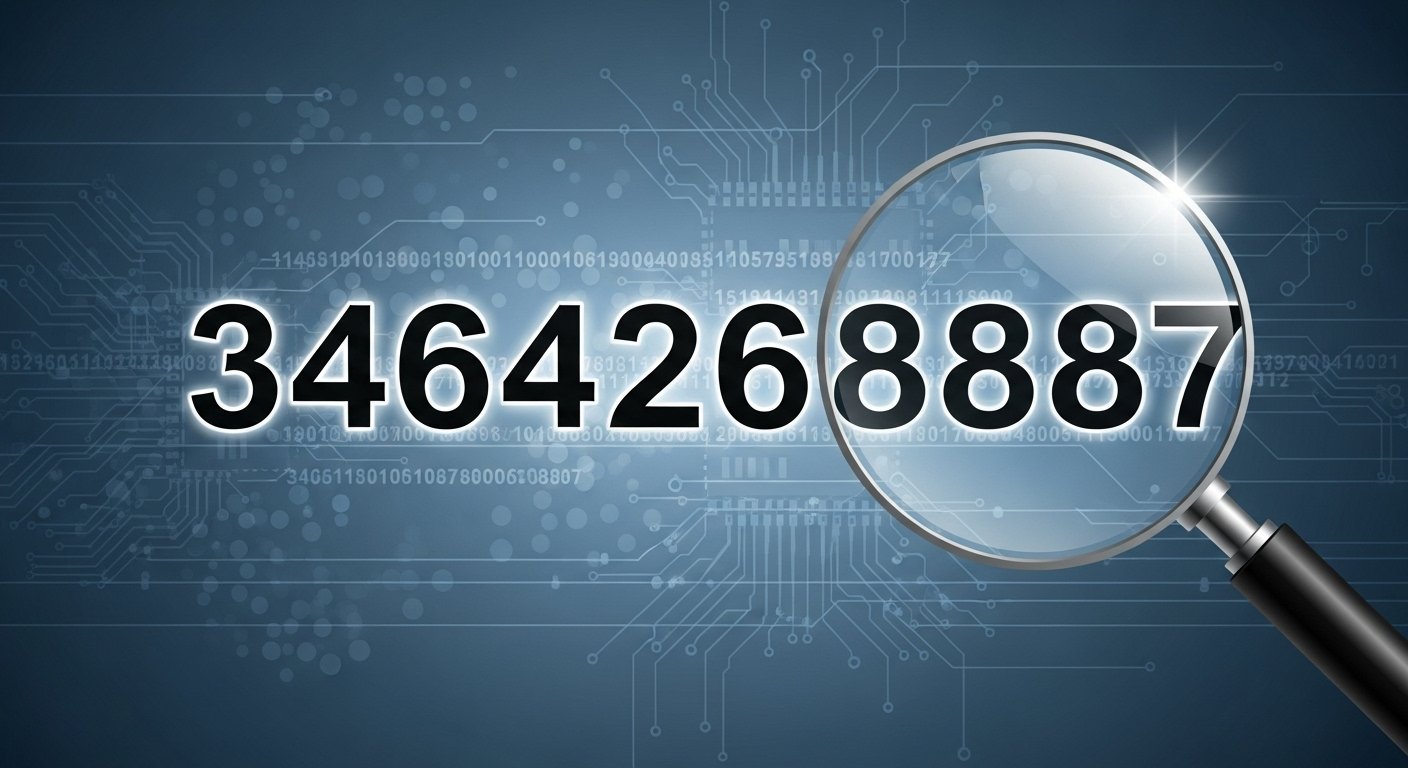In our digital age, numbers often carry significance beyond their face value. The number 3464268887 may look like a random sequence at first glance, yet it can relate to everything from tracking codes to account numbers or unique identifiers. Understanding 3464268887 can be useful whether you encounter it in an email, a service invoice, or a database. In this article, we’ll dive into how to interpret this number, possible contexts where it appears, and why it’s worth paying attention to the details.
What Is 3464268887?
Simply put, 3464268887 is a ten-digit numeric string. At first glance, it doesn’t follow a commonly known formatted code like a phone number with area code or standard credit card number pattern. However, its length and structure suggest it could serve one of several roles:
Possible uses of 3464268887
-
Reference or invoice number: Many companies assign unique numeric identifiers to transactions or tickets.
-
Account or customer ID: Banking or service platforms often use long numbers to uniquely identify users.
-
Tracking or shipment code: Logistics firms sometimes employ numeric sequences to track parcels or packages.
-
Database primary key: Internally, systems use long numeric values to avoid accidental duplication.
Because the number is purely numeric and of a standard length (10 digits), it may slip into multiple contexts. The key is understanding the environment where you found it.
Why the Format of 3464268887 Matters
When you see “3464268887,” the structure—10 digits without letters or symbols—helps narrow down possibilities. Let’s break down why format is relevant:
1. Length
Ten digits is standard for many phone numbers in certain countries (though usually formatted with separators). But if no separating characters are present and the context isn’t a call log, then it likely isn’t a phone number in that form.
2. Numeric only
The lack of punctuation (dashes, spaces) suggests it may be used as a database key or internal code: simple, uniform, and machine-friendly.
3. No prefix or suffix
Many tracking codes have letters or check digits. Pure numeric sequences often reflect system-generated IDs with minimal human-friendly formatting.
By analysing the pattern and length, you gain clues about the nature of 3464268887.
How to Determine What 3464268887 Refers To
If you encounter 3464268887 and want to figure out its meaning, here’s a simple step-by-step approach.
Step 1: Note the context
Where did you see 3464268887? Was it on a bill, in an email, on a website, or part of a data export? The surrounding elements give vital clues.
Step 2: Look for labels
Often an identifier will have a label like “Invoice #”, “Tracking ID”, “Customer ID”, etc. If you see “Ref: 3464268887”, then it’s clearly a reference number.
Step 3: Check with the service provider
If you suspect it’s related to a transaction or account, contact the relevant company and ask them what the number corresponds to. They can verify if 3464268887 is valid in their system.
Step 4: Check for validity
If you believe it’s a tracking code, enter it into the company’s tracking site. If it’s an account or user ID, open the system dashboard or portal and attempt to search for that number. Note: Never attempt to access unauthorized systems.
Step 5: Safety check
If you received 3464268887 unexpectedly (for example via SMS or email) and you don’t know the sender, treat it cautiously. It may be a phishing attempt or spam. Legitimate companies usually clearly indicate what a number means.
Common Scenarios Where 3464268887 Could Appear
Here are some real-world scenarios where you might find a number like 3464268887 and how to interpret it:
Scenario 1: On a service invoice
If you receive an invoice with “Transaction ID: 3464268887”, it means this is the unique identifier your service provider uses to track and log your payment or service entry.
Scenario 2: In an email with shipping details
You might encounter “Your parcel is being tracked under ID 3464268887”. In this case, the logistics company uses this number to reference your shipment.
Scenario 3: Within an online account statement
If your user account page lists “Customer No: 3464268887”, then it serves as your unique account number in that system.
Scenario 4: As part of a data export
In a business analytics scenario, you might see a spreadsheet column labeled “Order_ID” and value 3464268887. This means it is simply a key used internally.
In each scenario, the number isn’t inherently meaningful—it’s the context that gives it meaning.
Tips for Handling Identifiers Like 3464268887
When dealing with identifiers such as 3464268887, follow these best practices to keep things clear and safe.
1. Keep a record
If you receive the number in a transaction, take note of the service provider, date, and any linked activity. This helps if follow-up is needed.
2. Avoid sharing publicly
Treat numbers like account IDs or invoices as potentially private. Publicly sharing them could enable identity or account compromise.
3. Use search cautiously
If you attempt to “Google” the number 3464268887, be mindful that you may find unrelated or fraudulent references. Always confirm with the service provider.
4. Verify before trusting
If someone contacts you claiming “Your ID is 3464268887” and asks for personal data—stop, verify independently. Legit services won’t ask for sensitive data just based on a number.
5. Backup correspondence
Save emails or screenshots that reference 3464268887 so you have the full context (sender, date, subject) in case you need to return to it later.
Why Understanding Identifiers Like 3464268887 Is Important
At a glance, the number 3464268887 seems inconsequential—but understanding these identifiers matters for multiple reasons.
1. Accuracy in communication
When you reference the correct number in support calls or emails, things get resolved faster. Saying “My ID is 3464268887” is far more precise than saying “I have some account”.
2. Avoiding confusion
Knowing what the number stands for prevents mistaken identity or referring to an incorrect transaction.
3. Security
Understanding and verifying identifiers helps spot phishing or scam attempts where fake numbers are used to mislead you.
4. Data integrity
In business and analytics, unique numbers like 3464268887 ensure that every record is correctly accounted for—no duplicates, no mix-ups.
Common Mistakes to Avoid with Numbers Like 3464268887
Even small mistakes around such numbers can lead to big headaches. Here are some pitfalls:
-
Mis-typing the number – A single digit error in 3464268887 may direct you to a completely different record.
-
Assuming format equals type – Just because it’s ten digits doesn’t automatically make it a phone number or credit card.
-
Ignoring context – Using the number without noting what it’s referencing may lead to submitting the wrong info.
-
Posting it publicly – Sharing account or invoice numbers openly can expose you to fraud risk.
-
Trusting unknown sources – If someone contacts you claiming that 3464268887 is your tracking number but you didn’t initiate anything, treat it skeptically.
Conclusion
While the number 3464268887 in isolation may look like a random string, it likely plays a specific role depending on where you encountered it. Whether as an account ID, tracking reference, invoice number or internal key, understanding the context and following safe handling practices helps you make sense of it—and use it correctly. Keep the tips above in mind, verify whenever needed, and you’ll turn what looks like an arbitrary sequence into a clear and useful identifier.
Frequently Asked Questions (FAQs)
Q1: Can I assume 3464268887 is my phone number?
A: Not necessarily. While ten digits may resemble a phone number in some countries, unless it’s labelled as such or follows your country’s formatting, it’s safer to confirm what it represents.
Q2: Is the number 3464268887 unique?
A: It depends on the system assigning it. In many cases, yes—such identifiers are unique within their context (e.g., one customer per ID). However, uniqueness outside that system isn’t guaranteed.
Q3: What should I do if I receive 3464268887 from an unknown sender?
A: Treat with caution. Contact the claimed provider independently using known contact information and verify the meaning of that number. Do not share personal info just because a number is given.
Q4: Can I search 3464268887 online to see where it comes from?
A: You can attempt a search, but results may be misleading. It’s better to rely on the context in which you received the number and verify with the entity directly.
Q5: Do I need to save 3464268887 somewhere?
A: Yes—if it relates to a transaction (invoice, service request, shipment), save the email or screenshot with the number and date for future reference. It may be important for tracking, support, or inquiry purposes.

